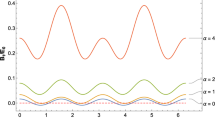Abstract
The generalized Curie-Weiss model is an extension of the classical Curie-Weiss model in which the quadratic interaction function of the mean spin value is replaced by a more general interaction function. It is shown that the generalized Curie-Weiss model can have a sequence of phase transitions at different critical temperatures. Both first-order and second-order phase transitions can occur, and explicit criteria for the two types are given. Three examples of generalized Curie-Weiss models are worked out in detail, including one example with infinitely many phase transitions. A number of results are derived using large-deviation techniques.
Similar content being viewed by others
References
M. Cassandro, E. Olivieri, A. Pellegrinotti, and E. Presutti,Z. Wahrsch. Verw. Geb. 41:313–334 (1978).
F. J. Dyson, inMathematical Aspects of Statistical Mechanics, J. C. T. Pool, ed. (American Mathematical Society, Providence, Rhode Island, 1972), pp. 1–11.
T. Eisele and R. S. Ellis,Z. Wahrsch. Verw. Geb. 63:297–348 (1983).
R. S. Ellis,Entropy, Large Deviations, and Statistical Mechanics (Springer, New York, 1985).
R. S. Ellis, J. L. Monroe, and C. M. Newman,Commun. Math. Phys. 46:167–182 (1976).
R. S. Ellis and C. M. Newman,Z. Wahrsch. Verw. Geb. 44:117–139 (1978).
R. S. Ellis and C. M. Newman,Trans. Am. Math. Soc. 237:83–99 (1978).
R. S. Ellis, C. M. Newman, and J. S. Rosen,Z. Wahrsch. Verw. Geb. 51:153–169 (1980).
M. E. Fisher,Phys. Rev. 162:480–485 (1967).
R. B. Griffiths,Commun. Math. Phys. 6:121–127 (1967).
K. Husimi, inProceedings of the International Conference of Theoretical Physics, H. Yukawa, ed. (Science Council of Japan, Tokyo, 1953), pp. 531–533.
J.-W. Jeon, Central limit theorems in the regions of large deviations with applications to statistical mechanics, Dissertation, Florida State University (1979).
J.-W. Jeon, inProceedings of the 3rd Japan-Korea Joint Conference of Statistics (Kyoto University, 1985).
M. Kac, inStatistical Physics: Phase Transitions and Superfluidity, M. Chretien, E. P. Gross, and S. Deser (Gordon and Breach, New York, 1966), Vol. 1, pp. 241–305.
O. G. Mouritsen, B. Frank, and D. Mukamel,Phys. Rev. B 27:3018–3031 (1983).
C. M. Newman, Shock waves and mean field bounds—Concavity and analyticity of the magnetization at low temperature, Preprint, University of Arizona; also, talk given at 46th Statistical Mechanics Meeting, Rutgers University (December 1981).
P. A. Pearce,J. Stat. Phys. 25:309–320 (1981).
B. Simon,J. Stat. Phys. 22:491–493 (1980).
J. Slawny,J. Stat. Phys. 32:375–388 (1983).
A. D. Sokal,J. Stat. Phys. 28:431–439 (1982).
H. N. V. Temperley,Proc. Phys. Soc. A 67:233–238 (1954).
C. J. Thompson,Commun. Math. Phys. 24:61–66 (1971).
C. J. Thompson,Mathematical Statistical Mechanics (Macmillan, New York, 1972).
J. O. Vigfusson,Lett. Math. Phys. 10:71–77 (1985).
Author information
Authors and Affiliations
Rights and permissions
About this article
Cite this article
Eisele, T., Ellis, R.S. Multiple phase transitions in the generalized Curie-Weiss model. J Stat Phys 52, 161–202 (1988). https://doi.org/10.1007/BF01016409
Received:
Issue Date:
DOI: https://doi.org/10.1007/BF01016409




